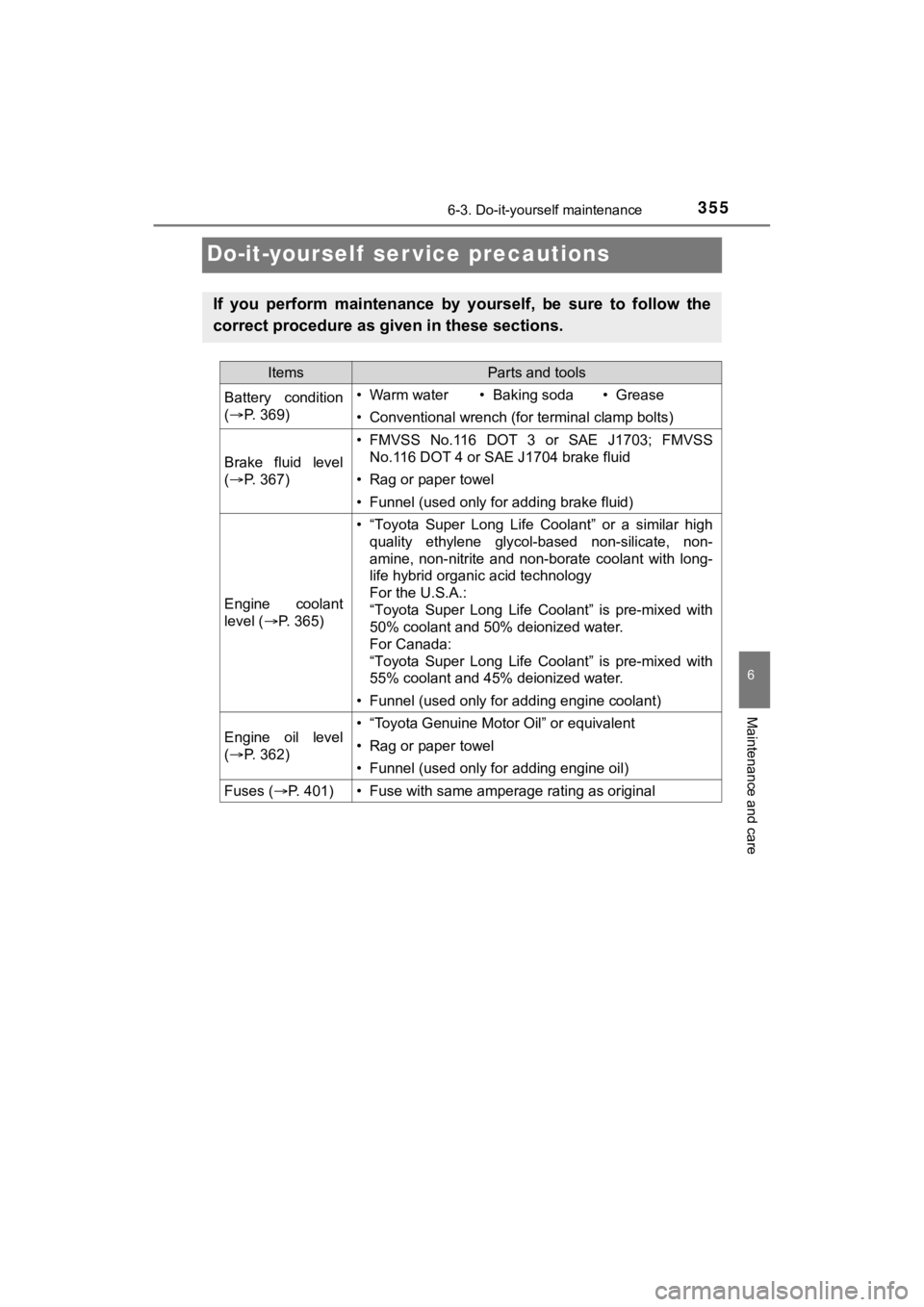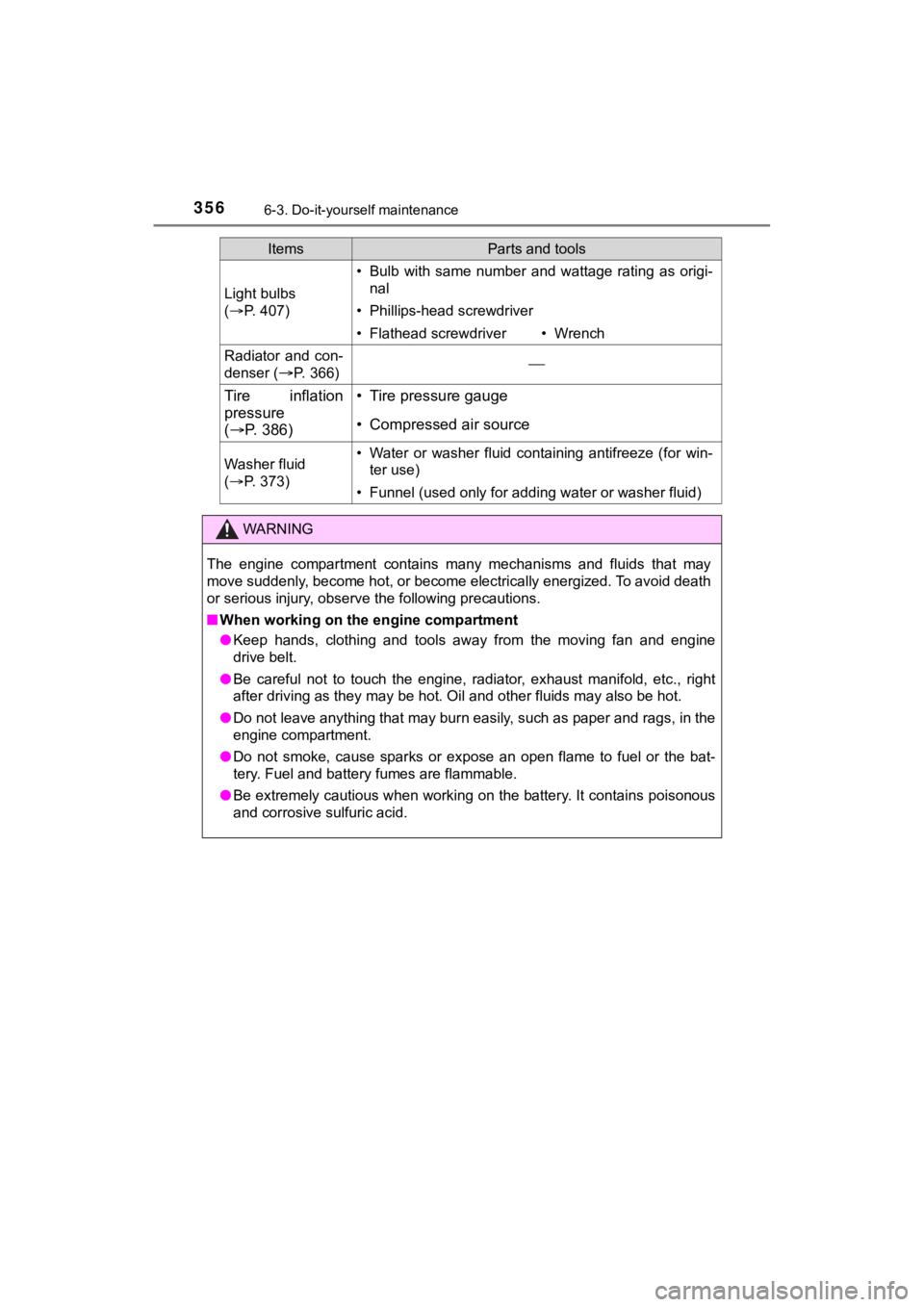Page 350 of 548
3506-2. Maintenance
C-HR_OM_USA_OM10684U
General maintenance
Listed below are the general maintenance items that should be
performed at the intervals specified in the “Owner’s Warranty
Information Booklet” or “Own er’s Manual Supplement/Sched-
uled Maintenance Guide”. It is recommended that any problem
you notice should be brought to the attention of your Toyota
dealer or qualified s ervice shop for advice.
Engine compartment
ItemsCheck points
BatteryCheck the connections. (P. 369)
Brake fluidIs the brake fluid at the correct level? ( P. 367)
Engine coolantIs the engine coolant at the correct level?
(P. 365)
Engine oilIs the engine oil at the correct level? ( P. 362)
Exhaust systemThere should not be any fumes or strange sounds.
Radiator/condenserThe radiator and condenser should be free of for-
eign objects. (P. 366)
Washer fluidIs there sufficient washer fluid? (P. 373)
Page 354 of 548

3546-2. Maintenance
C-HR_OM_USA_OM10684U
Emission inspection and maintenance (I/M)
programs
The OBD system determines that a problem exists somewhere in th e
emission control system. Your vehicle may not pass the I/M test and
may need to be repaired. Contact your Toyota dealer to service the
vehicle.
● When the battery is disc onnected or discharged
Readiness codes that are set duri ng ordinary driving are erased.
Also, depending on your driving habits, the readiness codes may
not be completely set.
● When the fuel tan k cap is loose
The malfunction indicator lamp illuminates, indicating a tempor ary
malfunction, and your vehicle may not pass the I/M test.
An OBD system error co de will not be cleared unless the vehicle is
driven 40 or more times.
Contact your Toyota dea ler to prepare the vehicle for re-testin g.
Some states have vehicle emission inspection programs which
include OBD (On Board Diagnostics) checks. The OBD system
monitors the operation of t he emission control system.
If the malfunction indicator lamp comes on
Your vehicle may not pass the I/M test in the following situations:
When the malfunction indicator lamp remains on after several
driving trips
If your vehicle does not pass the I/M test
Page 355 of 548

3556-3. Do-it-yourself maintenance
6
Maintenance and care
C-HR_OM_USA_OM10684U
Do-it-yourself ser vice precautions
If you perform maintenance by yourself, be sure to follow the
correct procedure as given in these sections.
ItemsParts and tools
Battery condition
( P. 3 6 9 )• Warm water• Baking soda• Grease
• Conventional wrench (for terminal clamp bolts)
Brake fluid level
( P. 3 6 7 )
• FMVSS No.116 DOT 3 or SAE J1703; FMVSS
No.116 DOT 4 or SAE J1704 brake fluid
• Rag or paper towel
• Funnel (used only for adding brake fluid)
Engine coolant
level ( P. 365)
• “Toyota Super Long Life Coolant” or a similar high
quality ethylene glycol-based non-silicate, non-
amine, non-nitrite and non-borate coolant with long-
life hybrid organic acid technology
For the U.S.A.:
“Toyota Super Long Life Coolant” is pre-mixed with
50% coolant and 50% deionized water.
For Canada:
“Toyota Super Long Life Coolant” is pre-mixed with
55% coolant and 45% deionized water.
• Funnel (used only for adding engine coolant)
Engine oil level
( P. 3 6 2 )• “Toyota Genuine Motor Oil” or equivalent
• Rag or paper towel
• Funnel (used only for adding engine oil)
Fuses ( P. 401)• Fuse with same amperage rating as original
Page 356 of 548

3566-3. Do-it-yourself maintenance
C-HR_OM_USA_OM10684U
Light bulbs
( P. 4 0 7 )
• Bulb with same number and wattage rating as origi-
nal
• Phillips-head screwdriver
• Flathead screwdriver• Wrench
Radiator and con-
denser (
P. 366)
Tire inflation
pressure
( P. 386)• Tire pressure gauge
• Compressed air source
Washer fluid
( P. 3 7 3 )• Water or washer fluid containing antifreeze (for win-
ter use)
• Funnel (used only for adding water or washer fluid)
WARNING
The engine compartment contains many mechanisms and fluids that may
move suddenly, become hot, or become electrically energized. To avoid death
or serious injury, observe the following precautions.
■When working on the engine compartment
● Keep hands, clothing and tools away from the moving fan and eng ine
drive belt.
● Be careful not to touch the engine, radiator, exhaust manifold, etc., right
after driving as they may be hot. Oil and other fluids may also be hot.
● Do not leave anything that may burn easily, such as paper and r ags, in the
engine compartment.
● Do not smoke, cause sparks or expose an open flame to fuel or t he bat-
tery. Fuel and battery fumes are flammable.
● Be extremely cautious when working on the battery. It contains poisonous
and corrosive sulfuric acid.
ItemsParts and tools
Page 361 of 548
3616-3. Do-it-yourself maintenance
6
Maintenance and care
C-HR_OM_USA_OM10684U
Engine compartment
Washer fluid tank (P. 373)
Engine coolant reservoir ( P. 365)
Fuse boxes ( P. 401)
Engine oil filler cap ( P. 363)
Engine oil level dipstick ( P. 362) Battery
( P. 369)
Brake fluid reservoir ( P. 367)
Electric cooling fan
Condenser ( P. 366)
Radiator ( P. 366)
Page 369 of 548
3696-3. Do-it-yourself maintenance
6
Maintenance and care
C-HR_OM_USA_OM10684U
Check the battery as follows.
■Battery exterior
Make sure that the battery terminals are not corroded and that
there are no loose connections, cracks, or loose clamps.
Terminals
Hold-down clamp
■Checking battery fluid
If there are lines on th e side of the battery:
Check that the leve l is between the upper and lower lines.
Upper line
Lower line
If the fluid level is at or below the
lower line, add distilled water.
Battery
Page 370 of 548
3706-3. Do-it-yourself maintenance
C-HR_OM_USA_OM10684U
If there are not lines on the side of the battery:
Check the fluid level as follows. Remove the vent plug.
Check the fluid level by look-
ing directly at the cell.
If the fluid level is low, add dis-
tilled water.
Put the vent plug back o n and close it securely.
■Adding distilled water
Remove the vent plug.
Add distilled water.
Put the vent plug back o n and close it securely.
1
LowO.K.O
P
N
O
P
Page 371 of 548

3716-3. Do-it-yourself maintenance
6
Maintenance and care
C-HR_OM_USA_OM10684U
■Before recharging
When recharging, the battery produces hydrogen gas which is flammable and
explosive. Therefore, observe the following before recharging:
●If recharging with the battery installed on the vehicle, be sur e to disconnect
the ground cable.
● Make sure the power switch on the charger is off when connectin g and dis-
connecting the charger cables to the battery.
■ After recharging/reconnecting the battery (vehicles with a smar t key sys-
tem)
● The engine may not start. Follow the procedure below to initial ize the sys-
tem.
Shift the shift lever to P.
Open and close any of the doors.
Restart the engine.
● Unlocking the doors using the smart key system may not be possi ble imme-
diately after reconnecting the battery. If this happens, use the wireless
remote control or the mechanical key to lock/unlock the doors.
● Start the engine with the engine switch in ACCESSORY mode. The engine
may not start with the engine switch turned off. However, the e ngine will
operate normally from the second attempt.
● The engine switch mode is recorded by the vehicle. If the batte ry is recon-
nected, the vehicle will return the engine switch mode to the s tatus it was in
before the battery was disconnected. Make sure to turn off the engine switch
before disconnecting the battery. Take extra care when connecti ng the bat-
tery if the engine switch mode prior to discharge is unknown.
If the system will not start even after multiple attempts at al l methods above,
contact your Toyota dealer.
1
2
3